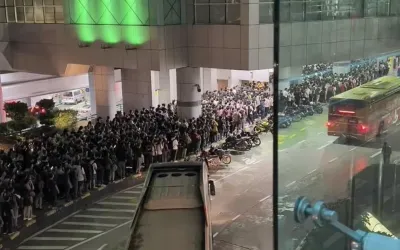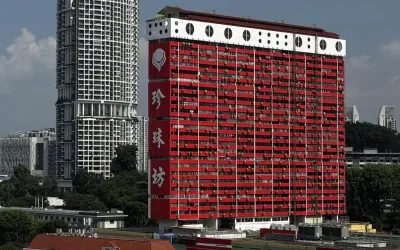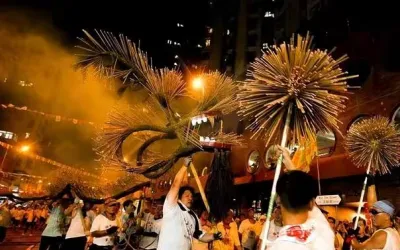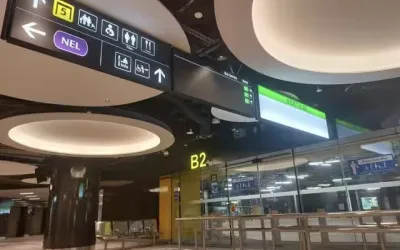2013年客工骚乱(图片来自网络)
受事件影响,新加坡政府采取了为客工建造宿舍的措施。2014年的政府文件中甚至有“如在宿舍附近设立价格合理的日用品店,客工就可以不需要离开宿舍区域、进入本地居民区(去购买生活用品)”这样的记录。似乎认为只要把客工和本地社群分得够开,冲突就会减少。很多社会组织和医疗专家都曾对这个治标不治本的计划提出异议,指出人员密集的宿舍将成为传染病的温床——而七年后的今天,担忧变成了现实。
In December 2013, the government ordered the construction of additional worker dormitories after some 300 migrant workers rioted following the death of a fellow worker in a bus accident (the first instance of such unrest in 40 years). Neighborhood residents subsequently decried the behavior of migrant workers living in the area, prompting the government to build dormitories with more attached facilities so that workers would not have to venture into areas where Singaporeans live. “Dormitory-based provision shops, especially if reasonably priced, could also encourage some workers to stay at their dormitory rather than travel out to a congregation area,” said a 2014 investigative committee report. Now, seven years later, these dormitories have become epicenters of Singapore’s COVID-19 crisis, validating early - and unheeded - warnings from NGOs and healthcare experts that they can easily become hotbeds of transmission.
客工的宿舍生活?
How Do Migrant Workers Live?
在新加坡,大约三十万名客工都住在宿舍里,一部分是专为他们设置的宿舍,还有一些是工地上的临时宿舍。宿舍条件十分恶劣,空间小、不通风,而一般都会有十几名客工挤在这样的房间里。由于宿舍里没有配套厨房,客工们也没有时间做饭,他们通常会买盒饭吃——工资的四分之一换来的是缺乏营养和卫生安全保障的饮食。辛苦而危险的工作加上糟糕的居住条件——几乎令人难以想像在新加坡这样一个发达的国家,还有人过着这样的生活。
Approximately 300,000 migrant workers are split between Singapore’s 43 mega-dormitories, 1,200 factory-converted dormitories, and temporary living quarters on construction sites. Their rooms—which often house over ten people—are sometimes unsanitary and poorly ventilated. With neither kitchens nor time to cook, migrant workers pay a substantial amount of their salaries for catered food that is often spoiled and lacking in nutrients.

客工宿舍(图片来自网络)
值得庆幸的是,在疫情之下,客工面临的这些问题终于开始受到重视,并且逐步得到改善。政府承认了自己的疏忽,越来越多的新加坡人也开始了解客工,并为他们的权益行动了起来。当然,偏见仍然存在。4月13日联合早报(新加坡的主要中文报纸之一)上的一篇社论仍然将疫情的二次爆发归咎于客工们不良的卫生习惯和生活习性。这篇文章随即引起了轩然大波,新加坡内政部部长也直接站出来批评这种充满偏见的言论。这样强烈的社会反响体现出舆论的转变:新加坡的主流社会已经不能接受狭隘的仇外心理。当然,舆论变化是否能够带来切实的行动仍然有待观察。
Nevertheless, with greater social awareness and media coverage of their plight, the situation for migrant workers has started to improve. The government has acknowledged its initial oversight, and many sympathetic Singaporeans have been galvanized to help. Of course, prejudice still exists: for example, an April 13 letter to the Editor published in Zaobao, Singapore’s most popular Chinese-language daily newspaper, blamed the COVID-19 outbreak on migrant workers’ personal hygiene and cultural habits. However, the storm of criticism this incited, including comments from Minister for Home Affairs and Law K. Shanmugam, suggests that mainstream opinion no longer tolerates such xenophobia. Sentiment on the ground does indeed appear to be shifting, although whether this will last beyond the current crisis remains to be seen.

原本8人一间的客工宿舍,由于疫情改为3人一间(图片来自网络)

部分客工被疏散至更为宽敞的居住场所,例如图中的军营(图片来自网络)
客工,不单单是新加坡的问题
A Worldwide Problem
这次的疫情不仅给新加坡人上了重要的一课,也给其他许多存在客工问题的社会带来了巨大的影响。在德国,东欧劳工工作的屠宰场由于卫生条件差和拥挤导致了上百人的疫情爆发(例:德国600多名屠宰场工人确诊);在泰国,许多来自缅甸、老挝和柬埔寨的客工因疫情丢了工作又回不了家,陷入进退维谷的境地(例:泰国外籍劳工怎么办?);沙特和阿联则直接遣返了大量来自埃塞俄比亚的劳工(例:埃塞政府不再向中东的埃塞公民分发现金援助)。对于客工而言,他们既得不到外国政府的福利保障,也无法指望自己的国家能成为疫情之下的避风港;面对疫情,他们没有工作、没有补助、没有社会的关心,孤立无援,束手无策。
Looking beyond Singapore, the COVID-19 pandemic has highlighted the plight of low-wage migrants around the world, many of whom lack basic rights, healthy living conditions, and access to quality healthcare. In Germany, cramped, squalid living quarters and overcrowded buses used to ferry workers might have contributed to the infection of hundreds of Eastern Europeans working in abattoirs. Countries like Saudi Arabia and the United Arab Emirates have deported Ethiopian workers by the thousands over COVID-19 concerns. In Thailand, thousands of migrant workers from neighboring Myanmar, Laos, and Cambodia found themselves stranded without employment or aid when the government closed all of its borders to inbound and outbound travel. Because most social welfare measures are linked to permanent places of residence, migrant workers could not access aid to purchase daily necessities. With no work or food, thousands walked home - sometimes more than 1000km. Many died of heat, hunger, fatigue, or road accidents.

图片来自网络
客工的问题同时也折射出了全球化的双面性。客工现象是人力资本在全球化浪潮中重新配置的表现之一,这一群体为各国的经济增长作出了巨大贡献,却并没有享受到与其贡献匹配的回报。客工遭遇的困境以及疫情的蔓延这类全球性挑战对各国在全球化时代的治理提出了新的要求。希望这次疫情所激起的社会关注不会随着时间又一次消失殆尽,也希望这种关注能够促进社会各界加强对客工这一群体的了解和重视,促使决策者制定更加公平的劳工政策。
The migrant worker crisis also reflects globalization’s double-faced nature. The very existence of the migrant worker phenomenon is itself a result of the global redistribution of human capital, which has created communities that have made extraordinary contributions to the economic development of each country they appear in. However, many have not managed to reap the rewards of their sacrifices. The plight of migrant workers and the spread of the COVID-19 pandemic are interconnected global challenges that present new governance issues for all countries. We can only hope that the collective attention the pandemic has drawn to migrant worker communities will outlast the current crisis, and will result in a renewed commitment to ensure equitable treatment for those who build and maintain the very foundation that cities like Singapore stand upon.
























